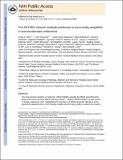The SETDB1 histone methyltransferase is recurrently amplified in and accelerates melanoma
Author(s)
Ceol, Craig J.; Houvras, Yariv; Jane-Valbuena, Judit; Bilodeau, Steve; Orlando, David A.; Battisti, Valentine; Fritsch, Lauriane; Lin, William M.; Hollmann, Travis J.; Ferre, Fabrizio; Bourque, Caitlin; Burke, Christopher J.; Turner, Laura; Uong, Audrey; Johnson, Laura A.; Beroukhim, Rameen; Mermel, Craig H.; Loda, Massimo; Ait-Si-Ali, Slimane; Garraway, Levi A.; Young, Richard A.; Zon, Leonard I.; ... Show more Show less
DownloadYoung_The SETDBI.pdf (1.837Mb)
OPEN_ACCESS_POLICY
Open Access Policy
Creative Commons Attribution-Noncommercial-Share Alike
Alternative title
The histone methyltransferase SETDB1 is recurrently amplified in melanoma and accelerates its onset
Terms of use
Metadata
Show full item recordAbstract
The most common mutation in human melanoma, BRAF(V600E), activates the serine/threonine kinase BRAF and causes excessive activity in the mitogen-activated protein kinase pathway[subscript 1, 2]. BRAF(V600E) mutations are also present in benign melanocytic naevi3, highlighting the importance of additional genetic alterations in the genesis of malignant tumours. Such changes include recurrent copy number variations that result in the amplification of oncogenes[subscript 4, 5]. For certain amplifications, the large number of genes in the interval has precluded an understanding of the cooperating oncogenic events. Here we have used a zebrafish melanoma model to test genes in a recurrently amplified region of chromosome 1 for the ability to cooperate with BRAF(V600E) and accelerate melanoma. SETDB1, an enzyme that methylates histone H3 on lysine 9 (H3K9), was found to accelerate melanoma formation significantly in zebrafish. Chromatin immunoprecipitation coupled with massively parallel DNA sequencing and gene expression analyses uncovered genes, including HOX genes, that are transcriptionally dysregulated in response to increased levels of SETDB1. Our studies establish SETDB1 as an oncogene in melanoma and underscore the role of chromatin factors in regulating tumorigenesis.
Date issued
2011-03Department
Whitehead Institute for Biomedical ResearchJournal
Nature
Publisher
Nature Publishing Group
Citation
Ceol, Craig J. et al. “The Histone Methyltransferase SETDB1 Is Recurrently Amplified in Melanoma and Accelerates Its Onset.” Nature 471.7339 (2011): 513–517.
Version: Author's final manuscript
ISSN
0028-0836
1476-4687